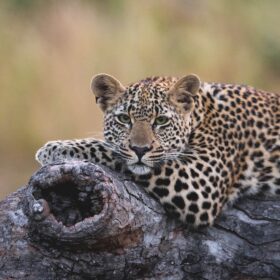A few months ago, Ranger Kelsey Clark posed the question, “Where is the Flat Rock Male?” I can safely say that, even though sightings of him are less frequent, after recently enjoying a beautiful sighting of him on the Northern bank of the Sand River, he still holds territory on Londolozi and is a force to be reckoned with amongst other male leopards in the area.
Born 2013 Kruger, seized prime territory at young age. Strategic dominance led to successful lineage before current eastward shift.
In her article, Kelsey alluded to the fact that the Flat Rock Male has shifted territories over the last few years. This can mainly be attributed to the shifting dynamics in male leopards in the area, as well as the need for genetic diversity amongst the leopard gene pool. The Flat Rock Male was the first leopard that I saw at Londolozi and I’ll never forget admiring his broad face and brazen demeanour. At the time, he held territory in the central and southwestern parts of Londolozi and was frequently seen close to camp, mostly south of the Sand River.

The Flat Rock Male descends a termite mound with his gaze fixated on a herd of impalas in the distance.
The Senegal Bush Male, although one year older and therefore closer to nearing the end of his prime, encroached into this area and forced the Flat Rock Male further north. Increased pressure from the Maxim’s Male entering the fray resulted in a further movement to the north and east. This pressure is a result of the shifting dynamics that I have mentioned, whereby new male leopards do what they know best and attempt to establish territories in areas where resources such as food, water and females are abundant.

The Flat Rock male loses his temper as the females snarl and hiss at one another, vying for his attention.
Leopards have also been known to significantly shift their territories during the latter part of their prime. This is especially important in ensuring genetic diversity amongst the leopard population. Independent, sexually mature females that were most likely sired by Flat Rock Male and who are territorial in central and southeestern Londolozi include; the Plaque Rock Female (RIP) and Nkuwa Female. After his first northward shift, he then sired both the Thumbela Female and Ngungwe Female who are now also of an age to reproduce. It is therefore crucial for his territory to shift further afield to avoid mating with his offspring.
![Backlit Flat Rock Male Walking (2) [rcb]](https://media.londolozi.com/wp-content/uploads/2024/06/10140131/Backlit-Flat-Rock-Male-Walking-2-RCB-720x1080.jpg)
Backlit photography can be challenging. The golden light filtering through from behind the leopard is what makes this photograph, for me at least.
His reign will mostly likely continue for roughly another two years, and will depend on which females he is able to produce offspring with and whether other male leopards continue to encroach on his turf. We will be sure to keep you informed of any developments on this magnificent male leopard!












![Flat Rock Male Walking Causeway [rcb]](https://media.londolozi.com/wp-content/uploads/2024/06/10140004/Flat-Rock-Male-Walking-Causeway-RCB-720x1080.jpg)
![Backlit Flat Rock Male Scent Marking (2) [rcb]](https://media.londolozi.com/wp-content/uploads/2024/06/10140057/Backlit-Flat-Rock-Male-Scent-Marking-2-RCB-1398x932.jpg)










Robert, thank you for the update. It is always interesting to see the shifts in territory.
The Flat Rock male is a leopard you can’t forget easily. His name keeps resounding as well as the Senegal Bush male. At a certain age leopards are nearly a legend. I’m still sad for The Plaque Rock female, she was alike him and the last video of her playing so energetically with her cub in that beautiful golden light was precious, like the pictures here. I read in his card that her took the territory of the 4:4 male that was killed by lions too. The number of leopards killed by lions is quite high… Wishing a golden road ahead for this mythical big cat I take time to look at the pictures again, smiling when he lifts his tail in front of you in the car like cats do….
Great to see him and know he continues to thrive!
Thanks for this interesting update on the Flat Rock Male. There have really been fewer sightings of him or at least fewer news about him. So, it’s nice to know that he is still doing fine. Beautiful photos!
Thanks for this update on the Flat Rock Male leopard Robert! So many wonderful images here, and I think my favorite is the golden light back-lit photo – quickly followed by the epic “on-the-prowl” shot of him descending the termite hill as he stalks the herd of impalas. He really is a handsome leopard, and as he ages and pressures continue to cause him to relocate, I am hoping he stays on Londolozi for the next couple of years and we can enjoy more posts about his continued success.
Flat Rock is a gorgeous boy and a very relaxed cat.
Robbie the the Flat rock male is a superb leopard. He has a hard job to keep territory as the Senegal bush male and Maxim’s male are nearby. Maxim’s male being so huge and I think he is younger the Flat rock male, would be terrible if they got in a fight over territory. Please keep us up to date with his where abouts,
Dear Robert, thank you for that update. Its nice to know , whats going on with this leopar. And thanks for that wonderful pictures with special lights, Great
It’s great to know that Flat Rock is still doing well in the northern region of the territory, most likely in the same area where he was scent marking along the road last year. In addition to the encroachment north by the Maxim’s male, wasn’t the Tortoise Pan male seen in that area as well? As far as females in this area, I’m aware that Xinzele drifts between Londolozi and the neighboring territory but what other female calls part of the north her own?